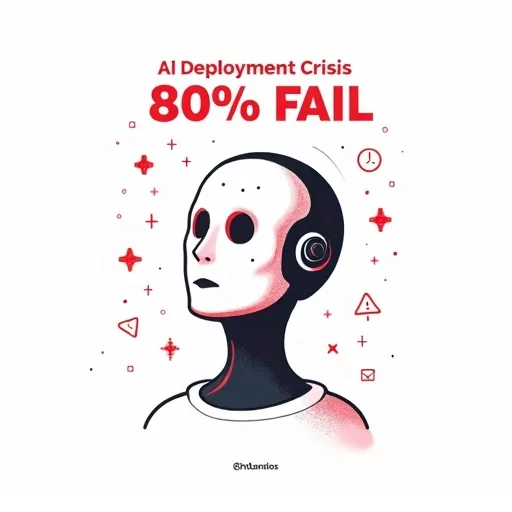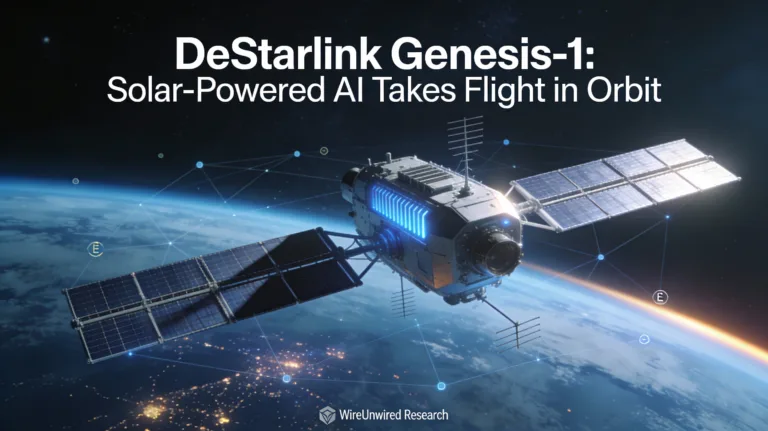The artificial intelligence industry experienced a wake-up call in August 2025 when OpenAI’s highly anticipated GPT-5 launch stumbled due to user backlash over the model’s perceived “colder” personality. CEO Sam Altman’s candid admission that the company “totally screwed up some things on the rollout” highlights a broader crisis facing the AI industry: the massive gap between development promises and production reality.
This high-profile stumble isn’t an isolated incident. Recent industry analysis reveals that 80% of AI models never successfully deploy to production environments, representing billions in wasted investment and countless missed opportunities for technological advancement. The GPT-5 launch problems—from router malfunctions to personality misalignment—mirror the systemic challenges plaguing AI deployment across industries.
Why AI Model Deployment Keeps Breaking Down?
The GPT-5 launch exposed critical infrastructure vulnerabilities that extend far beyond OpenAI. On August 8, 2025, the model’s auto-switcher broke during launch day, causing GPT-5 to “seem way dumber” as users were incorrectly routed between different model versions. This technical failure forced OpenAI to reinstate GPT-4o for users who preferred its warmer, more conversational tone.
Top 2 Technical Reasons behind AI deployment problems…
- Integration complexity remains the primary barrier to AI deployment success. According to recent analysis, disparate software systems, legacy infrastructure, and disconnected data sources create insurmountable obstacles for 60% of AI projects. Even well-funded organizations like OpenAI struggle with seamless system integration, as evidenced by their router malfunction that disrupted the entire user experience.
- Scalability constraints compound these challenges. Models trained in controlled environments often fail when processing real-time data at enterprise scale. Computational demands can increase exponentially, making operational costs prohibitive. Cloud auto-scaling and edge computing solutions help, but require significant upfront infrastructure investment that many organizations cannot justify without proven ROI.
The pharmaceutical industry demonstrates both the potential and pitfalls of AI scaling. While numerous companies have used AI to cut drug discovery times by more than half, deployment failures in clinical trial management and regulatory compliance have cost the industry over $2.8 billion in abandoned AI projects since 2023.
TRENDING
When AI Doesn’t Meet Business Expectations….

GPT-5’s personality problems reveal a fundamental disconnect between technical capabilities and user expectations — a perfect small-scale example that demonstrates the exact same fundamental issues that are causing AI deployment failures across the entire industry. 41% of executives identify workforce-related issues, including training and cultural shifts, as top implementation challenges, while technical teams often prioritize model performance over business impact.
Top 2 Fundamental Business reasons behind AI deployment failure…
- The ROI justification problem is particularly acute. Without clear financial benefits, even sophisticated AI models struggle to secure deployment approval. 73% of executives plan to employ generative AI to alter their business models, yet most lack the frameworks to measure AI success using quantifiable metrics beyond technical benchmarks. OpenAI’s response to user feedback—quickly implementing personality adjustments to make GPT-5 “feel more approachable” with phrases like “Good question” and “Great start”—demonstrates the importance of user-centric design in AI deployment. However, this reactive approach highlights the industry’s failure to incorporate human factors engineering during initial development phases.
- Data governance challenges further complicate business alignment. 63% of leading companies are increasing cloud budgets to leverage generative AI, but data fragmentation and compliance requirements often prevent successful integration. Poor-quality or biased training data leads to unreliable outputs, eroding stakeholder trust and halting deployment efforts.
Beyond Deployment: How AI Is Driving Value While Facing New Barriers

Despite widespread deployment challenges, AI adoption continues accelerating across sectors. Nearly 49% of tech leaders surveyed in October 2024 stated that AI was “fully integrated” into their core strategies, indicating that successful organizations are finding ways to overcome implementation barriers.
Incremental improvements are driving transformative value. While breakthrough applications capture headlines, productivity, market speed, and revenue improvements of 20% to 30% across various business areas are the primary sources of AI value. In automotive and aerospace industries, AI adoption in R&D can cut time-to-market by 50% and reduce costs by 30%.
The responsible AI movement is gaining momentum as deployment failures highlight governance needs. 67% of top-performing companies are already benefiting from generative AI in product and service innovation, but 46% of executives prioritize differentiating their organization through Responsible AI practices. This shift toward ethical AI development may help address the personality and alignment issues that plagued GPT-5’s launch.
Data commons restrictions present new challenges for future AI development. The proportion of restricted tokens in web datasets jumped from 5-7% to 20-33% between 2023 and 2024, as websites implement protocols to prevent AI training data scraping. This trend could limit model diversity and performance, making successful deployment even more critical for AI companies’ survival.
The GPT-5 launch difficulties serve as a cautionary tale for an industry racing toward artificial general intelligence while struggling with fundamental deployment mechanics. As AI capabilities advance, the gap between laboratory performance and production reality threatens to widen further unless organizations prioritize integration, user experience, and business alignment alongside technical innovation.
Discover more from WireUnwired Research
Subscribe to get the latest posts sent to your email.




